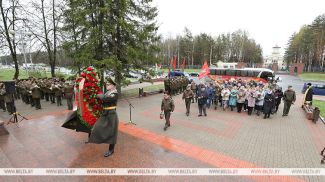MINSK, 15 February (BelTA) - The resolution of the European Parliament on the Belarusian nuclear power plant is a completely biased, groundless political step, Zsolt Harfas, a power engineer, member of the Board of Elektrotechnika (Hungary), said in his article for the Hungarian news website Origo, BelTA has learned.
The Hungarian expert noted that representatives of the European political parties who are opposed to nuclear energy and who support Lithuania's rhetoric, timed their resolution to the visit of ENSREG experts to the Belarusian nuclear power plant. "By doing so, they are trying to create the impression that the Belarusian nuclear power plant does not meet international standards, although the facts suggest quite the opposite. The resolution of the European Parliament is another vexing proof of the erroneous European energy policy, which discriminates against nuclear energy," Zsolt Harfas writes.
The safety and public acceptability of the nuclear power plant is a key issue for Belarus. Minsk has worked closely with international professional organizations since the launch of the construction of the nuclear power plant. "The statement that the Belarusian nuclear power plant does not comply with the recommendations of the International Atomic Energy Agency is a slander on the part of the European Parliament," Zsolt Harfas said.
At the invitation of the Belarusian government, the IAEA conducted a comprehensive inspection of new power units in 2017. The SEED mission assessed the readiness of the nuclear power plant to withstand external dangers and impacts.
“This mission concluded that Belarus is doing everything possible to ensure that the two new blocks under construction are able to withstand the most serious external impacts. The mission emphasized the high quality of the program to assess site-specific external hazards, as well as the integration into protective systems of 17 additional measures based on the experience gained from the Fukushima accident,” Zsolt Harfas recalled.
The power units of the Belarusian nuclear power plant are equipped with a VVER-1200 reactor. “It is noteworthy that after a detailed study of the Paks II Nuclear Power Plant project [in Hungary] the European Commission came to the conclusion that two new power units with VVER-1200 reactors meet the most stringent nuclear safety and radiation protection standards,” the expert said.
As for the mission of the European Nuclear Safety Regulators Group, the experts never called for the suspension of the commissioning of the BelNPP unit, although the European Parliament is trying to create such an impression in connection with the visit of the ENSREG mission,” Zsolt Harfas noted.
Inspections of European nuclear power plants, called stress tests, were initiated by ENSREG after the accident at Japan's Fukushima nuclear power plant caused by a strong earthquake and tsunami. These tests were carried out at operating nuclear power plants, including the Hungarian Paks, and recommendations were offered based on the results. Such a comprehensive test was not mandatory for Belarus, since the nuclear power plant was still under construction at that moment, yet the country decided to conduct stress tests of its nuclear power plant voluntarily in 2016-2018.
The stress tests consisted of three stages. First, a self-assessment of the fulfillment of the stress test requirements was done by the nuclear power plant which was under construction, after that a national assessment was carried out at the request of the Government of Belarus and under the supervision of the national nuclear safety watchdog. This work was assessed by ENSREG experts as part of a peer review.
The resistance of the nuclear power plant to natural disasters, including floods, earthquakes, and extreme weather events, as well as the resistance of the plant to combinations of adverse natural influences, which was one of the main lessons of the Fukushima events, was examined using the European methodology.
The second aspect under consideration was the safety of the nuclear power plant under conditions of complete power outage or loss of power supply, and also under conditions of loss of a coolant (water-water reactors). The third aspect was the management of hypothetical severe beyond design basis accidents. Based on this analysis, measures were formulated to increase safety margins. Taking into account the recommendations of the ENSREG peer review, 23 safety improvement measures were included in the national plan of action.
According to Zsolt Harfas, technical and engineering solutions used in the Belarusian nuclear power plant, and also its safety concept are designed to exclude accidents. Chances of a serious accident are extremely small, but nevertheless, after the Fukushima accident, the country should be prepared for such events as well. The BelNPP power supply is ensured in all situations, passive heat removal is also provided in case of loss of a coolant, and there is a core melt trap under the reactor in case of emergency.
The Hungarian expert believes that the European Parliament resolution questioning the compliance of the Belarusian nuclear power plant with international standards is a ‘completely biased political move'.
The Belarusian nuclear power plant will produce about 18 billion kWh of electricity per year after the commissioning of both units. The plant will meet about 40% of the country's electricity needs and replace the import of 4.5 billion cubic meters of natural gas per year. The plant will make a significant contribution to climate protection and the achievement of the goals set out in the Paris Climate Agreement.











